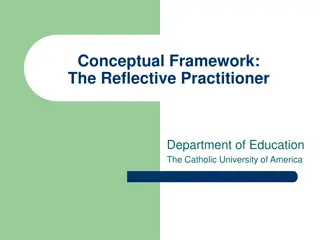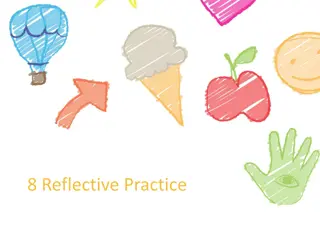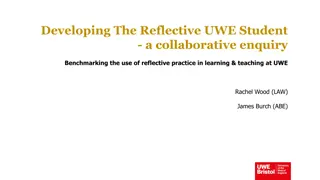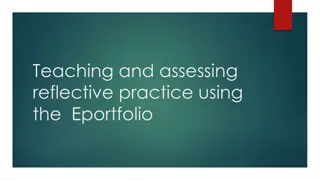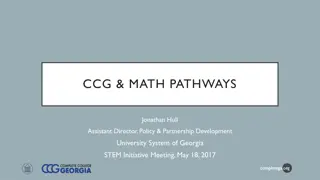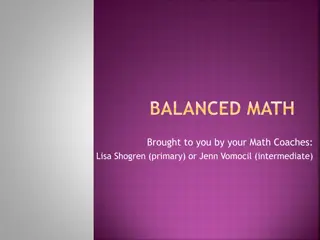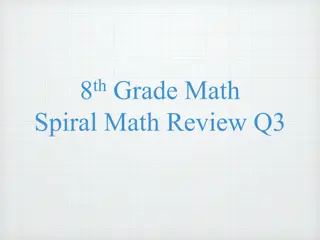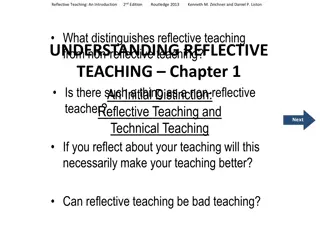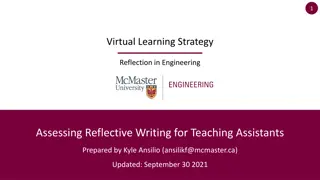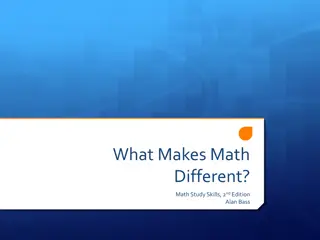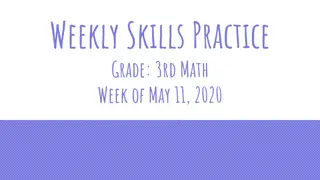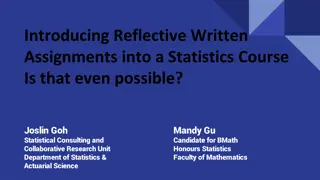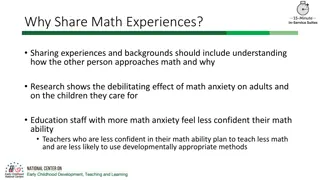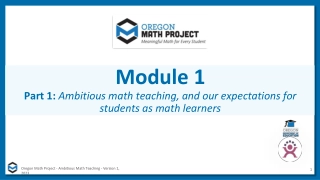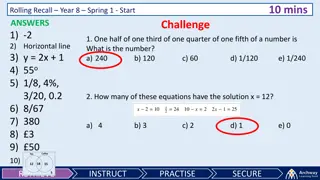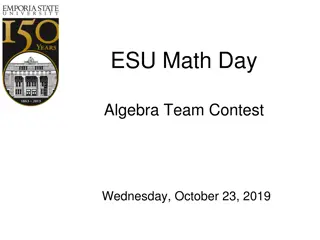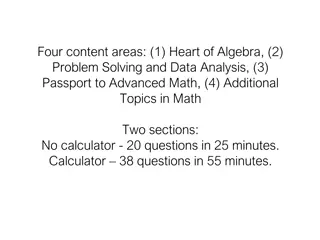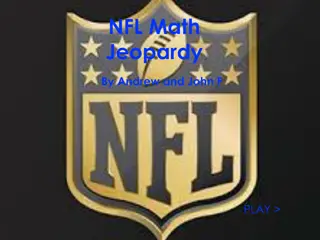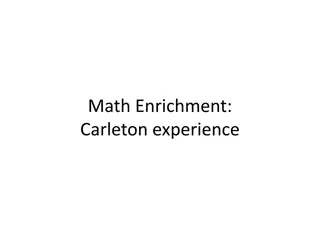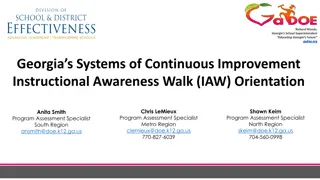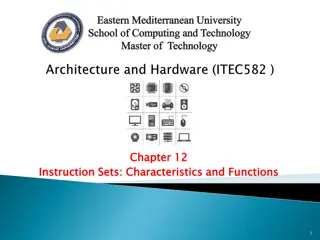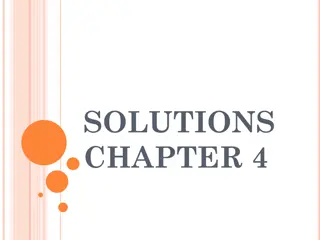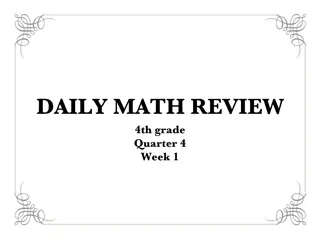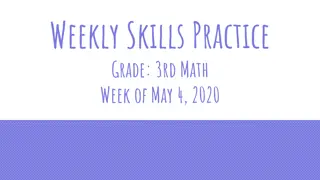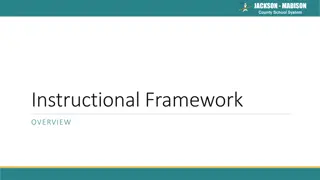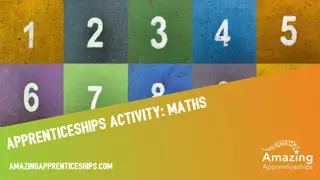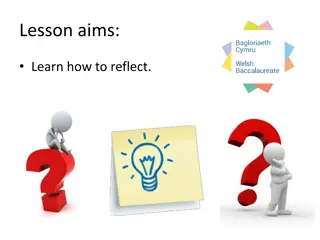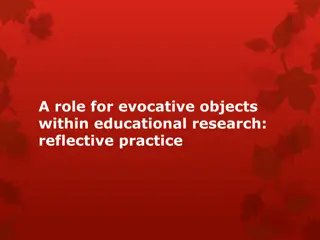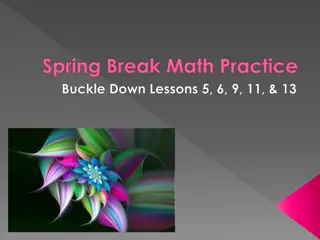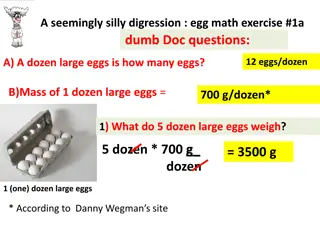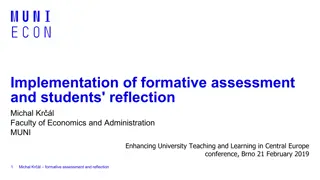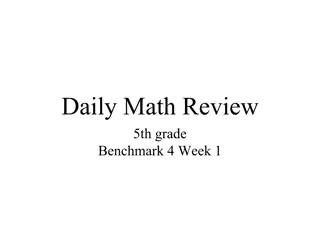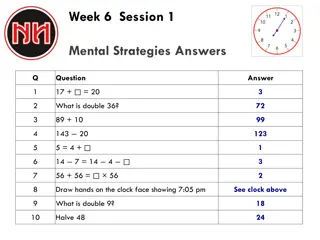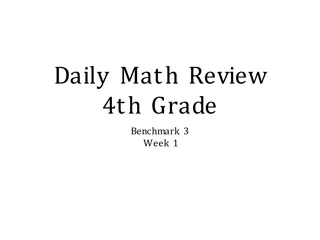Enhancing Math Instruction Through Reflective Practice
Explore strategies for implementing and maintaining fidelity in math tasks, investigate attribute changes with partners, set lesson goals, select examples for class discussions, and emphasize making connections among mathematical concepts. Reflect on linear vs. quadratic equations and advantages of various problem-solving approaches.
Download Presentation

Please find below an Image/Link to download the presentation.
The content on the website is provided AS IS for your information and personal use only. It may not be sold, licensed, or shared on other websites without obtaining consent from the author. Download presentation by click this link. If you encounter any issues during the download, it is possible that the publisher has removed the file from their server.
E N D
Presentation Transcript
Reflecting on Practice: Worthwhile Tasks Session 3 Implementing Tasks: Maintaining Fidelity Reflecting on Practice Park City Mathematics Institute 1
In this figure as the step changes, the _____________ also changes Step 1 Step 2 Step 3 Reflecting on Practice Park City Mathematics Institute 2 Peterson, 2006
With your partner, pick one of the attributes in our list and investigate how it changes. Make a conjecture and try to prove it. How would a graph, a table, and/or an equation support your conclusion? (If time, explore a 2nd or 3rd property) 3
As a table, decide what your lesson goal will be Possible goals: Distinguish between linear and quadratic relationships Distinguish between closed form and recursive rules for sequences Interpret numerical, algebraic and geometric representations of a mathematical concept Describe a geometric pattern by an algebraic expression Recognize a quadratic relationship and be able to find a closed form rule for the relationship Recognize and be able to describe the components of an arithmetic sequence Explain what rate of change means in different situations Reflecting on Practice Park City Mathematics Institute 4
As a table, keeping your learning goal in mind, select four or five examples of work that you would want to have your class discuss. Sequence the work in the order in which you want the discussion to take place and be ready to defend your choice of sequence for the discussion. Reflecting on Practice Park City Mathematics Institute 5
It is important to bring ideas together for students. What connections would you want students to discuss? How would you help them see those connections? 6
Possible Discussion Points 1. Which changes led to linear equations and which lead to quadratic? Is there an explanation? 2. What were the advantages and disadvantages of different approaches (symbolic vs. tables vs. graphs vs diagrams)? 3. What is the distinction between patterns and proof? Is this important? Why or why not? 4. Identify where it was important to attend to precision . Reflecting on Practice Park City Mathematics Institute 7
Processing the activity What answers do you expect to see? (Anticipating) What are students doing? (Monitoring) What responses are worth discussing? (Selecting) How will you sequence responses? (Sequencing) What is the mathematical punchline? (Connecting) 8 Smith & Stein, 2011 5 Steps for a Productive Discussion
The 5 Practices Anticipate Monitor Select Sequence Connect Smith & Stein, 2011 9
Consider the three opportunities for discussion in this activity: with your partner as you investigated the change, explaining and questioning each other about your approaches and conclusions on the posters around the room, and the group discussion at the end about the mathematics. As a student, what was useful about each of those discussions? Reflecting on Practice Park City Mathematics Institute 10
Consider the three opportunities for discussion in this activity: with your partner as you investigated the change, explaining and questioning each other about your approaches and conclusions on the posters around the room, and the group discussion at the end about the mathematics. As a student, what was useful about each of those discussions? As a teacher in a classroom where these discussions were taking place, what would be useful to you? Reflecting on Practice Park City Mathematics Institute 11
What are some characteristics of tasks that promote discussion What is changing? Slanting sides of a quadrilateral Exponent rules Perpendicular diagonals of a quadrilateral What is Sorting Reflecting on Practice Park City Mathematics Institute 12
Participation quiz (PCMI, 2011) High school algebra class working on factoring. They are being graded on how well they work together on the task not on right answers. You have expectations about the way discussions should happen in your classroom. Do your students know what they are? As you watch, what norms are being established to encourage discussion? 13
What explicit norms does the teacher set for student discussion? What level math talk is going on in the class What things does the teacher do to promote math talk? Reflecting on Practice Park City Mathematics Institute 14
Sociomathematical Norms- talking about the math Explanations consist of mathematical arguments not simply procedural summaries of the steps taken to solve the problem. Errors offer opportunities to reconceptualize a problem and explore contradictions and alternative strategies. Mathematical thinking involves understanding relations among multiple strategies. Collaborative work involves individual accountability and reaching consensus through mathematical argumentation (Kazemi, 1998). Reflecting on Practice Park City Mathematics Institute 15
Norms for students working together Take turns Listen to others ideas Disagree with ideas not people Be respectful Helping is not the same as giving answers Confusion is part of learning Say your becauses I can t do that yet? Horn, 2012
References Horn, I. (2012). Strength in numbers: Collaborative learning in secondary mathematics. Reston VA: National Council of Teachers of Mathematics Peterson, B. (2006). Linear and quadratic change: A problem from Japan. The Mathematics Teacher, 100(3). Reston VA: National Council of Teachers of Mathematics. Smith, M., & Stein, M.(2011). 5 practices for orchestrating productive mathematics discussions. Reston VA: National Council of Teachers of Mathematics Reflecting on Practice Park City Mathematics Institute 17


